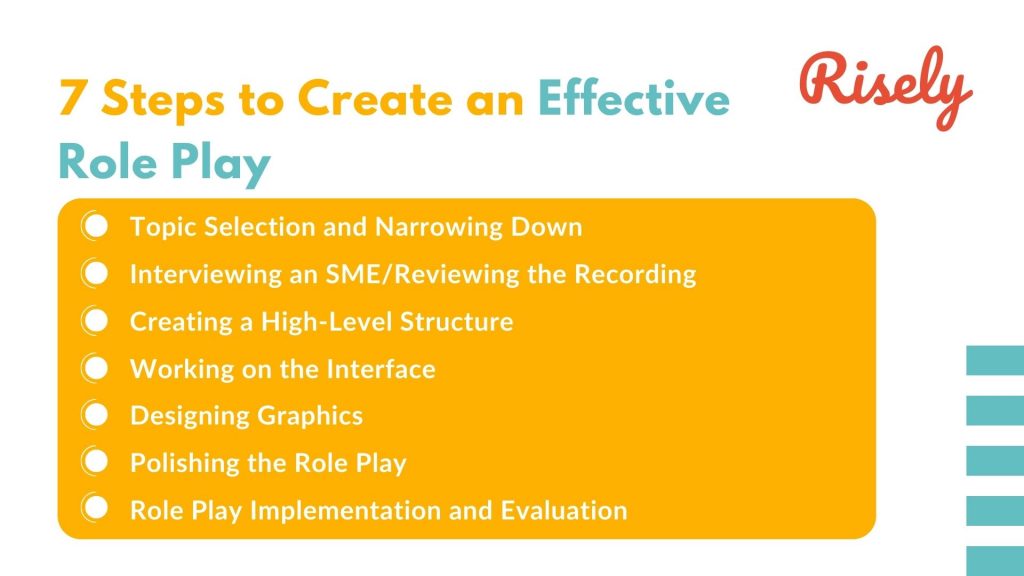Role Play Training at Work: 7 Effective Tips + Sample Situations
Are you tired of traditional training methods that fail to engage your employees and produce real results? It’s time to consider incorporating role-play training into your workplace. Role-play training is an effective and interactive technique that allows employees to practice real-life scenarios in a safe and controlled environment. In this blog, we will explore the benefits of role-play training, how to use it effectively, and provide sample situations that you can incorporate into your own training sessions. Additionally, we will guide you through the step-by-step process of creating an effective role-play, from topic selection to implementation and evaluation. Get ready to revolutionize your employee training with these practical tips and techniques.What is role-play training?
Role-play training rehearses real-life situations in a safe and controlled environment. It’s like actors preparing for a play, but it happens in the workplace or a training setting instead of a stage. In role-play, you and your colleagues step into different roles to simulate various scenarios you might encounter at work. In the words of Clark Aldrich, a pioneer in the field of educational simulations, “Role-plays empower you to teach soft skills that you simply couldn’t teach before.” The idea is to practice and improve essential communication, problem-solving, and decision-making skills. It’s like learning to swim in a pool before diving into the deep end. Through role-play, you can make mistakes without real consequences, learn from them, and build your confidence when you face similar situations. So, whether it’s handling customer complaints, training for emergency responses, or perfecting your sales pitch, role-play is a powerful tool to help you shine when the spotlight’s on.Benefits of Role Play Training
Role-play training provides a wide range of benefits for individuals and teams. Role-playing exercises enhance communication and collaboration skills among team members, resulting in more effective teamwork. This type of training also builds problem-solving and decision-making abilities, equipping individuals with the skills needed to tackle challenges successfully. Moreover, it creates a safe environment for practicing new skills and techniques, boosting confidence and reducing anxiety in real-life situations. Role-play training promotes empathy and understanding of different perspectives, fostering a more inclusive and supportive workplace. It also enables participants to receive immediate feedback and learn from their mistakes, facilitating continuous improvement and growth. Incorporating role-play training into a training program can have a significant impact on team performance and overall employee development. Check out more here: Top 13 methods of employee training to boost workforce performanceHow to Use Role Play Training?
To leverage the benefits of role-play training, it is crucial to establish the training’s objectives and desired outcomes. It sets the stage for an effective learning experience. Engage participants by choosing realistic and relevant scenarios that stimulate their problem-solving abilities. Clear instructions and guidelines are essential before the role play begins, providing participants with a solid foundation for their performance. Foster active engagement and participation from team members, empowering them to learn and grow. Ensure feedback is provided after each session, allowing for immediate learning from mistakes and reinforcing positive behaviors. Encourage reflection through thoughtful exercises, enabling participants to analyze their own performance.Other Interesting Reads
Sample Situations for Role Play Training
Incorporating role-play exercises into training programs provides learners with a safe environment to practice and enhance their skills. Here are some specific situations where role-play training, or simulation or case studies, can be effective in the workplace.Effective Delegation Role Play Training Scenarios
Situation: A manager needs to delegate tasks to their team members. The manager can role-play delegating responsibilities for a project, clearly communicating expectations, providing necessary resources, and monitoring progress. Scenario: You are the manager of a project team and you have a tight deadline approaching. One of your team members falls ill suddenly and cannot complete their assigned tasks. In this role play, you need to delegate the tasks to the remaining team members while ensuring that the workload is distributed fairly and the project remains on track.Time Management Role Play Training Scenarios
Situation: An employee struggles with managing their workload and meeting deadlines. Role-play can involve prioritizing tasks, creating a schedule, and practicing techniques like setting realistic goals, eliminating distractions, and dealing with unexpected interruptions. Scenario: You are a sales manager responsible for managing multiple clients and projects simultaneously. You have a full day of meetings and deadlines to meet. However, unexpected issues arise throughout the day, such as urgent client requests and technical glitches. In this role play, you must prioritize your tasks, manage your time effectively, and handle these unexpected challenges while ensuring important deadlines are not compromised.Strategic Thinking Role Play Training Scenarios
Situation: A team is facing a complex business challenge. The role-play can involve analyzing the situation, identifying opportunities and risks, brainstorming innovative solutions, and making strategic decisions based on long-term goals and organizational priorities. Scenario: You are the CEO of a company facing increased competition in the market. Your board of directors is looking for strategies to stay ahead of the competition and explore new business opportunities. In this role play, you must analyze market trends, assess the strengths and weaknesses of your company, and develop a strategic plan to position your organization for long-term success.Collaboration Role Play Training Scenarios
Situation: Two departments need to work together on a cross-functional project. The role-play can involve fostering effective collaboration, building rapport, establishing clear communication channels, resolving conflicts, and leveraging the strengths of each team to achieve a common goal. Scenario: You are a team leader responsible for overseeing a cross-functional project that requires collaboration between departments that have different priorities and work styles. In this role play, you must facilitate effective communication, resolve conflicts, and encourage collaboration to ensure that the project goals are met while addressing the diverse needs and perspectives of the team members.Critical Thinking Role Play Training Scenarios
Situation: An employee needs to make an important decision with limited information. The role-play can involve analyzing available data, considering different perspectives, evaluating potential risks and benefits, and reaching a well-reasoned decision using critical thinking skills. Scenario: You are a product manager tasked with evaluating a potential acquisition opportunity for your company. You have limited information available and need to assess the financial viability, strategic fit, and potential risks associated with the acquisition. In this role play, you must gather relevant data, analyze it critically, and make a well-reasoned decision while considering various factors and potential outcomes.7 Steps to Create an Effective Role Play
Now lets explore 7 steps for an effective role play:Step 1: Topic Selection and Narrowing Down
When it comes to role-play training, the first step is to focus on topic selection and narrowing down. Begin by choosing a specific area of focus or skill that you want to address during the training program. This will help create a purposeful and relevant role-play exercise for your team members. Consider the goals and objectives you want to achieve through role play, such as problem-solving or enhancing communication skills. Additionally, take into account any specific challenges or real-life situations that your team encounters in their work. By selecting a particular problem or case study, you can ensure that the role-play exercise has relevance to their day-to-day responsibilities. Once you have identified the topic, determine the roles and characters that will be involved in the role play, including the facilitator or role player. Finally, create a clear and concise script or outline for the role play, incorporating specific learning points and real-world scenarios.Step 2: Interviewing an SME/Reviewing the Recording
The second step involves interviewing an SME (subject matter expert) or reviewing recordings of real-life situations. This step provides valuable insights to create relevant and realistic scenarios. During the interview or review process, it’s crucial to gather detailed information about the specific challenges and nuances of the given situation. You can ensure accuracy and capture all relevant details by taking notes or recording the conversation. Attention to language, behaviors, and actions in real-world scenarios helps create a more authentic role-play exercise. Asking for examples or stories of successful problem-solving in specific situations can be a great learning opportunity for the team.Step 3: Creating a High-Level Structure
A high-level structure is vital when it comes to role-play training. To create this structure, you must identify your main objectives and the specific skills or behaviors you want participants to develop. Choose a scenario or situation that allows participants to effectively showcase these skills. Outline the necessary steps and actions within the role play, and don’t forget to incorporate challenges and obstacles for a more realistic experience. Lastly, allocate time for each phase, ensuring a well-structured and organized role-play exercise.
Step 4: Working on the Interface
Working on the Interface in role-play training involves establishing clear guidelines and expectations for participant interaction. It is crucial to encourage active listening and respectful communication between participants. By providing opportunities for participants to practice effective communication skills, such as paraphrasing and asking clarifying questions, they can enhance their understanding and engagement during the role-play exercise. Creating a safe environment where participants can feel comfortable making mistakes and learning from them is also important. Visual aids and props can be utilized to add realism to the role-play, simulating real-life situations and making the experience more immersive for the learners. Check out focused activities for active listening here: Here are 10 fun active listening exercises to become better at communicatingStep 5: Designing Graphics
Creating captivating graphics is crucial in role-play training as it enhances participants’ engagement and immerses them in the experience. Visual aids, charts, diagrams, and props are effective tools that help illustrate the scenario and provide vital information to learners. By incorporating relevant and visually appealing graphics, role-play exercises become more relatable to real-life situations, creating a safe environment for participants to practice problem-solving skills. Whether handling an angry customer or working as a team member in a sales team, graphics bring real-world scenarios into the training program, reinforcing the learning points and promoting active engagement.Step 6: Polishing the Role Play
Polishing the role play is a critical step in making it more realistic and effective. After the initial practice round, it’s essential to review the feedback received and make necessary changes to the script or scenario. This ensures that the role play aligns with the desired learning objectives. It’s also important to add complexity to challenge participants and encourage problem-solving. Rehearsing the revised role play with participants ensures smooth transitions, clear communication, and realistic interactions. Attention should be given to timing and pacing to maintain engagement and avoid rushing or dragging out the scenario. Implementing the polished role play in a safe environment allows participants to apply their skills and knowledge. The facilitator observes and provides feedback, focusing on improvement and highlighting strengths. A debriefing session facilitates reflection and discussion, helping participants apply learning in real-world scenarios.Step 7: Role Play Implementation and Evaluation
The true test lies in the implementation and evaluation phase of role-play training. After thorough preparation and rehearsal, it’s time to unleash the power of role-play in a real-life scenario. This is the moment where participants truly get to apply what they’ve learned. Ensure that each team member understands their role and objectives, creating a safe and supportive environment for them to navigate real-life situations. Set the scene by replicating the workplace setting, utilizing relevant props and materials. Encourage participants to fully immerse themselves in their roles, responding authentically to the given situation. After the role-play exercise, allow time for reflection and feedback from participants and observers. This valuable feedback helps in identifying learning points and areas for improvement, making role-play training an effective and transformative part of any training program. Done with the training program? Learn how to evaluate it: 5 Steps of Developing an Effective Training Evaluation Program: With Best PracticesTips for Conducting a Role-Playing Training
Conducting role-play training can be a highly effective way to enhance various skills and scenarios in your workplace. Here are some practical tips to help you make the most of it:- Set Clear Objectives: Before you start, define what you want to achieve with the role-play. What skills or situations are you targeting? Having clear objectives will guide the training.
- Prepare Realistic Scenarios: Create scenarios that mimic real-life situations as closely as possible. This helps participants connect their learning to their actual roles.
- Provide Guidelines: Give participants guidelines and background information about their roles and the scenario. This helps them step into character effectively.
- Rotate Roles: Encourage participants to switch roles during different scenarios. This allows everyone to experience various perspectives and challenges.
- Feedback and Debrief: After each role-play, have a debriefing session. Discuss what went well and what could be improved. Constructive feedback is essential for growth.
- Encourage Open Dialogue: Create a safe and open environment where participants can express themselves freely. This builds trust and makes the training more effective.
- Use Video Recording: If possible, record the role-plays. Watching the recordings can be a powerful learning tool, helping participants see their strengths and areas for improvement.
- Keep it Engaging: Role-play can be fun and engaging. Inject enthusiasm and energy into the training to keep everyone involved and motivated.
- Practice, Practice, Practice: Like any skill, the more you practice, the better you become. So, repeat role-play sessions periodically to reinforce learning.
Conclusion
Role-play training is a powerful tool that can enhance learning and development in the workplace. It allows employees to practice real-life scenarios and improve their skills in a safe and controlled environment. By engaging in role-play, participants can gain confidence, improve communication, and develop problem-solving abilities. Whether you are looking to enhance customer service skills, sales techniques, or leadership qualities, role-play training can be tailored to meet your specific needs.Practice your constructive feedback skills to ensure team success.
Learn more about the errors that hold you back as a manager through a free constructive feedback assessment.
Role Play Training FAQs
What is role play training?
Role play training is a method used in corporate settings to simulate real-life scenarios and encourage participants to act out specific roles or situations. It allows individuals to practice and develop skills in a safe and interactive environment, promoting experiential learning.
What is an example of role-playing in training?
An example of role-playing in training could be a customer service workshop where participants take turns playing the roles of both the customer and the customer service representative. They can simulate various scenarios, such as handling a complaint, providing product recommendations, or resolving a problem.
What are the 4 types of role-play?
The four types of role-play commonly used in training are:
a) Single-role play: One participant plays a specific role while others observe and provide feedback.
b) Multiple-role play: Participants take on different roles within a scenario, allowing interaction and perspective-taking.
c) Hot seating: One person takes on the role of an expert or authority figure and is questioned or challenged by others.
d) Fishbowl: A small group performs a role play in front of an audience, who then join in or provide feedback.
a) Single-role play: One participant plays a specific role while others observe and provide feedback.
b) Multiple-role play: Participants take on different roles within a scenario, allowing interaction and perspective-taking.
c) Hot seating: One person takes on the role of an expert or authority figure and is questioned or challenged by others.
d) Fishbowl: A small group performs a role play in front of an audience, who then join in or provide feedback.
How do you teach role-playing?
To teach role-playing, explain the purpose and benefits of role-play in training. Provide clear instructions and objectives for each role-playing exercise. Encourage participants to immerse themselves in their assigned roles, provide feedback and debriefing sessions after each role-play, and offer opportunities for reflection and discussion on the skills and lessons learned. Practice and repetition are key to improving role-playing abilities.
Other Related Blogs
Assertive Feedback Techniques ft. Gurleen Baruah
Assertive Feedback Techniques ft. Gurleen Baruah Let’s be real—giving feedback as a manager isn’t always easy. Say too little, and nothing changes. Say too much, and it might come off…
How to ask for feedback from employees? | Gurleen Baruah
How to ask for feedback from employees? | Gurleen Baruah Feedback is a two way street. This podcast took managers on a trip down the other side. As managers, we…
How to give a constructive feedback? | Gurleen Baruah
How to give a constructive feedback? | Gurleen Baruah Giving constructive feedback to help the team achieve more is one of the primary tasks of a manager. But, without the…
Let’s Reverse the Gaze of Radical Candor?
Let’s Reverse the Gaze of Radical Candor? Have you heard about Radical Candor? It’s a book by Kim Scott that first came out in 2017. The tagline is “Caring Personally…


